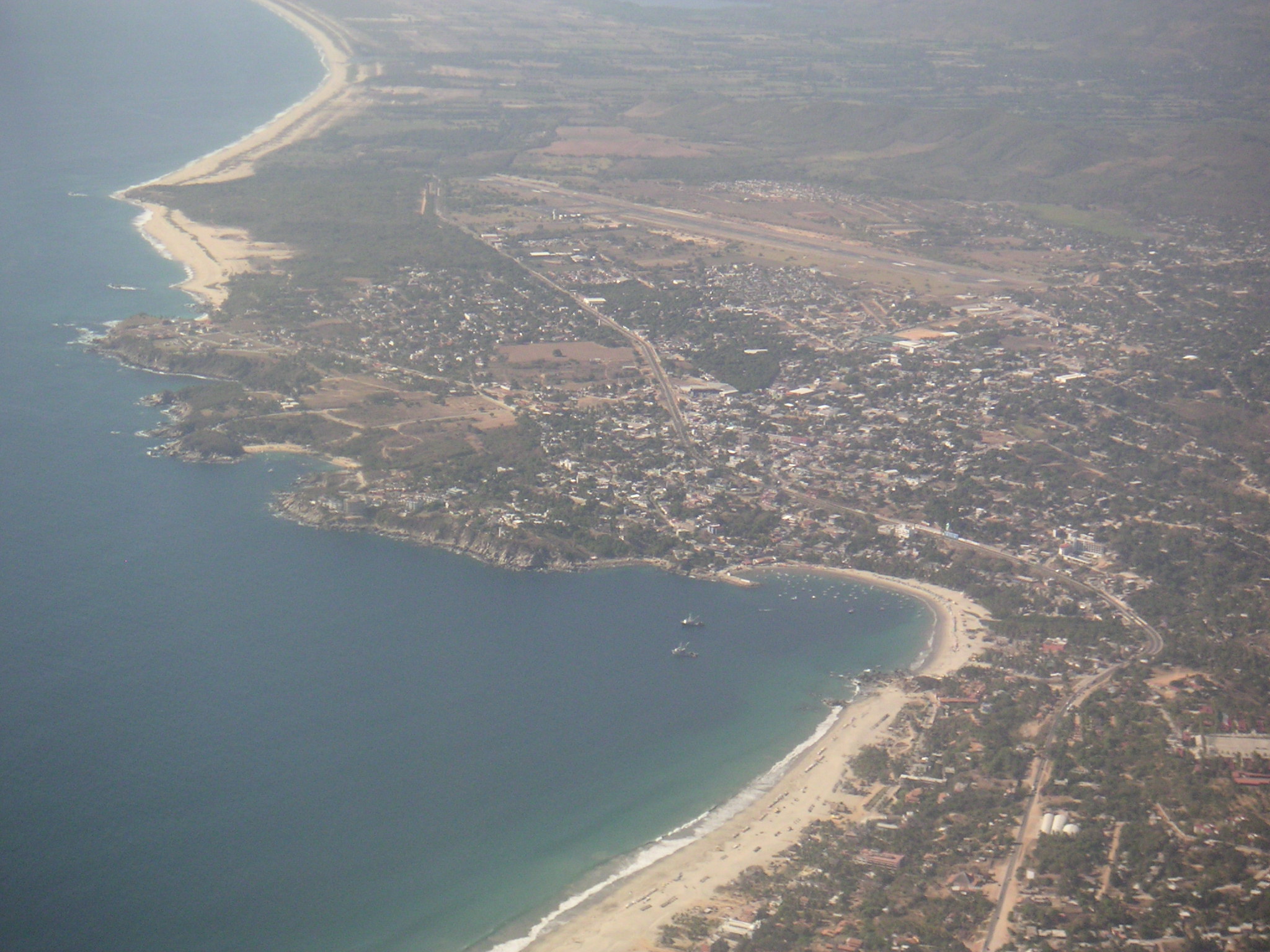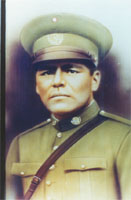|
Costa Region, Oaxaca
The Costa Region or Costa Chica lies on the Pacific coast of the state of Oaxaca, Mexico, south of the more mountainous Sierra Sur inland from the coast. It includes the districts of Jamiltepec, Juquila and Pochutla. Climate The region has a tropical climate in the coastal plain, with a more temperate climate higher up. Average temperatures range between , and maximum annual rainfall is between - Economy The population is mainly engaged in agriculture and waterfront fisheries. One of the best coffees in the world, the Pluma Hidalgo, is cultivated in the Pochutla district. In other parts of the region lemons are grown to make lemon oil, a raw material for perfumes and medicines. Pine and oak wood is harvested for plywood. Ranching is a major source of revenue. There is also small-scale exploitation of iron, copper and magnesium, and the region has titanium deposits. It is a tourist region, based on the beaches of Huatulco and Puerto Escondido. To develop this industry, ... [...More Info...] [...Related Items...] OR: [Wikipedia] [Google] [Baidu] |
Oaxaca
Oaxaca ( , also , , from nci, Huāxyacac ), officially the Free and Sovereign State of Oaxaca ( es, Estado Libre y Soberano de Oaxaca), is one of the 32 states that compose the political divisions of Mexico, Federative Entities of Mexico. It is divided into municipalities of Oaxaca, 570 municipalities, of which 418 (almost three quarters) are governed by the system of (customs and traditions) with recognized local forms of self-governance. Its capital city is Oaxaca de Juárez. Oaxaca is in southwestern Mexico. It is bordered by the states of Guerrero to the west, Puebla to the northwest, Veracruz to the north, and Chiapas to the east. To the south, Oaxaca has a significant coastline on the Pacific Ocean. The state is best known for #Indigenous peoples, its indigenous peoples and cultures. The most numerous and best known are the Zapotec peoples, Zapotecs and the Mixtecs, but there are sixteen that are officially recognized. These cultures have survived better than most others ... [...More Info...] [...Related Items...] OR: [Wikipedia] [Google] [Baidu] |
Mixtec
The Mixtecs (), or Mixtecos, are indigenous Mesoamerican peoples of Mexico inhabiting the region known as La Mixteca of Oaxaca and Puebla as well as La Montaña Region and Costa Chica Regions of the state of Guerrero. The Mixtec Culture was the main Mixtec civilization, which lasted from around 1500 BC until being conquered by the Spanish in 1523. The Mixtec region is generally divided into three subregions based on geography: the Mixteca Alta (Upper Mixtec or Ñuu Savi Sukun), the Mixteca Baja (Lower Mixtec or Ñuu I'ni), and the Mixteca Costa (Coastal Mixtec or Ñuu Andivi). The Alta is drier with higher elevations, while the Baja is lower in elevation, hot but dry, and the Coasta also low in elevation but much more humid and tropical. The Alta has seen the most study by archaeologists, with evidence for human settlement going back to the Archaic and Early Formative periods. The first urbanized sites emerged here. Long considered to be part of the larger Mixteca region, ... [...More Info...] [...Related Items...] OR: [Wikipedia] [Google] [Baidu] |
Tututepec
Tututepec is a Mesoamerican archaeological site. It is located in the lower Río Verde valley on the coast of Oaxaca that formed the nucleus of an extensive Mixtec state during the Late Postclassic period (ca. 12th to early 16th centuries). At its largest extent the site covered some 21.85 km2, and its political influence extended over an area of more than 25,000 km² of the neighbouring territory. Its name in Mixtec is ''Yucu Dzaa''.Joyce 2010 Today, the site is occupied by the contemporary settlement of Villa de Tututepec de Melchor Ocampo, in the Mexican state of Oaxaca Oaxaca ( , also , , from nci, Huāxyacac ), officially the Free and Sovereign State of Oaxaca ( es, Estado Libre y Soberano de Oaxaca), is one of the 32 states that compose the political divisions of Mexico, Federative Entities of Mexico. It is .... Notes References * * * * Mixtec sites {{mesoamerica-stub ... [...More Info...] [...Related Items...] OR: [Wikipedia] [Google] [Baidu] |
Jamiltepec
Santiago Jamiltepec (Mixtec: Casandoo) is a town, and the seat of surrounding municipality of the same name, in the Mexican state of Oaxaca. It is located in the Jamiltepec District in the west of the Costa Chica Region, 30 km east of Pinotepa Nacional on Federal Highway 200, and 460 km southwest of state capital Oaxaca de Juárez. The municipality In the 2005 INEGI census, the municipality reported a population of 17,206 inhabitants, of whom 4,155 spoke an indigenous language, predominantly Mixtec The Mixtecs (), or Mixtecos, are indigenous Mesoamerican peoples of Mexico inhabiting the region known as La Mixteca of Oaxaca and Puebla as well as La Montaña Region and Costa Chica Regions of the state of Guerrero. The Mixtec Culture wa .... As municipal seat, Santiago Jamiltepec has governing jurisdiction over the following communities: Atotonilquillo Charco Nduayoo Cuyuche, El Añil, El Guayabo, El Guineo, El Platanillo, El Santo, El Zapote Negro, El Zarzal ... [...More Info...] [...Related Items...] OR: [Wikipedia] [Google] [Baidu] |
Santa María Huatulco
Santa María Huatulco is a town and municipality in Oaxaca in south-western Mexico. It is part of the Pochutla District in the east of the Costa Region. The meaning of Huatulco, or Guatulco Coatulco is, "where they worship the tree", referring to an ancient legend. Geography The municipality covers an area of 579.22 km² at an average of 220 meters above sea level. The Magdalena and Cruz rivers combine in the municipality to form the Huatulco river. Its ecosystem is lowland deciduous and includes mahogany, cedar, cashew and many other species of tree. Wildlife includes squirrel, opossum, skunk, raccoon, coati, ringtail, armadillos, ocelots and white-tailed deer. History Hernán Cortés conquered the town of Huatulco on 8 January 1539. Demographics As of 2005, the municipality had a total population of 33,194 of which 1,119 spoke an indigenous language. The population includes many migrants from other areas drawn by the tourist business. Economic activities by numbers em ... [...More Info...] [...Related Items...] OR: [Wikipedia] [Google] [Baidu] |
Santa Catarina Juquila
Santa Catarina Juquila is a town in the State of Oaxaca, Mexico, and is the seat of the municipality also called Santa Catarina Juquila. It is part of the Juquila District in the center of the Costa Region. The name "Juquila" comes from "Xuhquililla", which means "Place of blue milkweed". Environment The total area of the municipality is 811.42 km2 in rugged terrain in the foothills of the Sierra Madre del Sur. The climate is temperate humid, with maximum temperatures of 20 °C, minimum 12 °C and average 16 °C.. Annual rainfall is 854 mm, higher from May to September and lower from October to April. Trees include pine, oak, mahogany, cedar, oak, coral, topehuaje, blackwood, ebony, jacaranda and ash. Fruit trees include orange, lemon, mamey, banana, pomegranate and guava. Wild fauna are deer, badgers, iguana and armadillo. Town The town has a population of 5,579 inhabitants and is at an altitude of 1,462 meters above sea level. It is located north of P ... [...More Info...] [...Related Items...] OR: [Wikipedia] [Google] [Baidu] |
Puerto Ángel
Puerto Ángel (English: "Angel Port").Is a small coastal town in the Mexican state of Oaxaca located in the municipality of San Pedro Pochutla. It, along with San Agustinillo and Playa Zipolite are known as the "Riviera Oaxaqueña". It is located 9 km south of city of Pochutla approximately 50 kilometers west of Huatulco and 80 kilometers east of Puerto Escondido. Despite tourism development since the 1960s, the town is still mostly a fishing village, located on a small bay surrounded by rocky hills that lead into the Sierra Madre del Sur. It was founded in the mid-19th century as a port for the region's coffee and lumber industries but since then other means of shipping these products has replaced it. History The community was founded in the 1850s when, through the efforts of Benito Juárez, the government built a wharf. At that time, this was a very isolated part of the country and the port was designed to help the area develop its coffee and lumber industries, by giving ... [...More Info...] [...Related Items...] OR: [Wikipedia] [Google] [Baidu] |
Pochutla
San Pedro Pochutla is a city and municipality located in the south of Oaxaca state, Mexico next to the Pacific Ocean. It is an important commercial, transportation and administrative hub for the Pochutla District, Oaxaca, Pochutla District in the east of the Costa Region, Oaxaca, Costa Region. Pochutla is located at the junction of coastal Mexican Federal Highway 200, Highway 200 and Mexican Federal Highway 175, Highway 175 to Oaxaca, with 175 functioning as the town's main thoroughfare. Its name means "place of kapok trees (Ceiba pentandra)", and most of the city is built on a lakebed which was drained during the colonial period. The municipality is best known as being the home of the oceanside communities of Puerto Ángel and Zipolite. History The Pochutla area was settled by Zapotec peoples, Zapotec tribes from Amatlán, Oaxaca, Amatlán, Miahuatlán, Oaxaca, Miahuatlán and Cuatlan in the 8th century. The settlement now known as Pochutla was founded around the same time as ... [...More Info...] [...Related Items...] OR: [Wikipedia] [Google] [Baidu] |
Pinotepa Nacional
Pinotepa Nacional (formally: Santiago Pinotepa Nacional; in Mixtec, ''Ñuu Ñoko'', which means Twenty-House Town) is a city and seat of the municipality of the same name, in the Mexican state of Oaxaca. It is located in the Jamiltepec District in the west of the Costa Region. The name Pinotepa means "toward the crumbling hill" in Náhuatl. The town During colonial times, its name was Pinotepa del Rey, and just after Independence, it was called Pinotepa del Estado. It is located at a height of 200 m above sea level in the Mixteca de la Costa region of the state. The region has an interesting history. A high percentage of its population is of African ancestry. There are two historical theories of how this came about. The first is that during the colonial period African slaves were brought to this area to work on the various haciendas here. The second theory is that these people are the descendants of Africans destined for the slave trade whose ship wrecked off the coast of ... [...More Info...] [...Related Items...] OR: [Wikipedia] [Google] [Baidu] |
San Juan Cacahuatepec
San Juan Cacahuatepec is a city in the Mexican state of Oaxaca, near the border with Guerrero. It is located in the Jamiltepec District in the west of the Costa Region. Its population in 1990, according to ''The Columbia Gazetteer of North America'', was 3,116; in 2006, it was about 5,000. Along with San Pedro Amusgos, it is a heavy center of population for the indigenous Amuzgo. The name Cacahuatepec is Nahuatl, translating "Place of Cacao-bean mountain". Agriculture of the area includes corn, beans, sugarcane, rice, and tropical fruits. History Once inhabited by Yopes, the area came under dominion of Spain in 1523.. Several times it has been impacted by unrest in the region. It was a gathering point for rebel forces of Hermenegildo Galeana in the early 19th century, and later, in 1854, it was razed by Antonio López de Santa Anna Antonio de Padua María Severino López de Santa Anna y Pérez de Lebrón (; 21 February 1794 – 21 June 1876),Callcott, Wilfred H., "Santa A ... [...More Info...] [...Related Items...] OR: [Wikipedia] [Google] [Baidu] |
Álvaro Carrillo
Álvaro Carrillo Alarcón (2 December 1921 - 3 April 1969) was a Mexican popular music composer and songwriter, born in San Juan Cacahuatepec, Oaxaca. He wrote over 300 songs, mostly boleros, including the great hits ''Amor mío'', ''Sabor a mí'', ''Como se lleva un lunar'', ''El andariego'', ''Luz de luna'', ''Sabrá Dios'', ''Seguiré mi viaje'' and '' La mentira''. Early life and education Álvaro Carrillo Alarcón was born in 1921 to a father of Spanish European descent and a mother of both Indigenous Mixtec and African descent. He came from a very humble family as they lived in extreme poverty. His father owned three cows which he believed made him a "rich" man and at that time it did, just to get an idea of the picture. Since his father was a country man who came from a long line of farmers he was eagerly set on keeping all his sons stuck to his family's business on the field. A very young Alvaro was not interested in obeying his father at all and would hide, instead of doi ... [...More Info...] [...Related Items...] OR: [Wikipedia] [Google] [Baidu] |
Zapotec Peoples
The Zapotecs ( Valley Zapotec: ''Bën za'') are an indigenous people of Mexico. The population is concentrated in the southern state of Oaxaca, but Zapotec communities also exist in neighboring states. The present-day population is estimated at approximately 400,000 to 650,000 persons, many of whom are monolingual in one of the native Zapotec languages and dialects. In pre-Columbian times, the Zapotec civilization was one of the highly developed cultures of Mesoamerica, which, among other things, included a system of writing. Many people of Zapotec ancestry have emigrated to the United States over several decades, and they maintain their own social organizations in the Los Angeles and Central Valley areas of California. There are four basic groups of Zapotecs: the ', who live in the southern Isthmus of Tehuantepec, the ', who live in the northern mountains of the Sierra Madre de Oaxaca, the southern Zapotecs, who live in the southern mountains of the Sierra Sur, and the Central Va ... [...More Info...] [...Related Items...] OR: [Wikipedia] [Google] [Baidu] |



